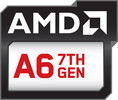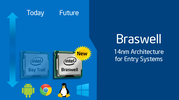AMD A6-9210 vs Intel Celeron N3060
AMD A6-9210
► remove from comparison
The AMD A6-9210 is an entry-level chip from the Stoney-Ridge APU series for notebooks (7th APU generation), which was announced mid 2016. At its launch, the A6-9210 is the mid-range Stoney Ridge processor (dual-core version of Bristol Ridge) and integrates two CPU cores (one Excavator module with 2 integer and on FP unit) clocked between 2.4-2.8 GHz. It also includes a Radeon R4 GPU, probably with 192 shaders at 600 MHz, as well as a single-channel DDR4-2133 memory controller, H.265 video engine and chipset with all I/O ports.
Architecture
Stoney Ridge is the successor of the Carrizo architecture and the design is almost identical. Thanks to optimized manufacturing processes and more aggressive Boost behavior, however, the clocks are a bit higher at the same power consumption. The memory controller now also supports DDR4-RAM, in this case up to 2133 MHz. Stoney Ridge is the designation for the smaller dual-core and single-core chip, while Bristol Ridge is the bigger quad-core chip with dual-channel memory controller. More technical details are available in the following articles:
Performance
Because of the significantly lower clock range, the A6-9210 should be noticeably slower than the A9-9410.
Graphics Card
The integrated Radeon R4 (Stoney Ridge) GPU is probably similar to the R5 with 192 active shader units (3 compute cores), but a reduced clock of just 600 instead of 800 MHz. More details about the GPU are available in the linked articles above.
Power Consumption
AMD specifies the TDP of the A6-9210 with 15 Watts, but it can be configured between 10-15 Watts. This means the APU is a good choice for thin and light notebooks.
Intel Celeron N3060
► remove from comparison
The Intel Celeron N3060 is a low-end dual-core SoC for notebooks, which has been presented in April 2015. It is clocked at 1.6 - 2.48 GHz and part of the Braswell platform. Thanks to its new 14 nanometer low-power process (P1273) with tri-gate transistors, energy efficiency has been significantly improved compared to its predecessor architecture Bay Trail (e.g. Celeron N2840). The N3060 is successor (refresh) to the Celeron N3050 and compared to it it offers a improved Turbo clock rate (2.48 vs 2.1 GHZ).
In addition to the CPU cores, the SoC offers a DirectX 11.2-capable GPU as well as a DDR3L Memory Controller (2x 64 bit, 25.6 GB/s).
Architecture
The processor cores are based on the Airmont architecture, which is basically a slightly modified shrink of the previous Silvermont core. While performance per clock has not been improved, the more efficient 14 nm process leads to a better utilization of the CPU Burst (alias Turbo Boost) and a therefore somewhat higher overall performance.
Performance
Depending on the cooling of the SoC, the Boost clock rate of 2.48 can be held for longer periods and therefore leading to a faster performance as the older Celeron N3050 that can only reach 2.16 GHz. Using Windows, the CPU is adequate for simple everyday tasks such as light Internet browsing or office applications, but not for complex software or modern games.
Graphics
The HD Graphics 400 (Braswell) is based on the Intel Gen8 architecture, which supports DirectX 11.2 and is also found in the Broadwell series (e.g. HD Graphics 5300). With 12 EUs (Execution Units) and a clock speed of up to 600 MHz, the GPU is almost twice as fast as the HD Graphics (Bay Trail), but still not powerful enough to handle modern 3D games. The GPU also supports 4K/H.265 video acceleration. Although featuring a different name, the GPU was not changed from the N3050 (named HD Graphics alone).
Power Consumption
The entire SoC is rated at an TDP of 6 watts (SDP 4 watts). Thus, the chip can be cooled passively.
| Model | AMD A6-9210 | Intel Celeron N3060 | ||||||||||||||||||||||||||||||||||||||||||||||||||||||||||||||||||||||||
| Codename | Stoney Ridge | Braswell | ||||||||||||||||||||||||||||||||||||||||||||||||||||||||||||||||||||||||
| Series | AMD Bristol Ridge | Intel Celeron | ||||||||||||||||||||||||||||||||||||||||||||||||||||||||||||||||||||||||
| Series: Celeron Braswell |
|
| ||||||||||||||||||||||||||||||||||||||||||||||||||||||||||||||||||||||||
| Clock | 2400 - 2800 MHz | 1600 - 2480 MHz | ||||||||||||||||||||||||||||||||||||||||||||||||||||||||||||||||||||||||
| L1 Cache | 1 MB | |||||||||||||||||||||||||||||||||||||||||||||||||||||||||||||||||||||||||
| Cores / Threads | 2 / 2 | 2 / 2 | ||||||||||||||||||||||||||||||||||||||||||||||||||||||||||||||||||||||||
| TDP | 15 Watt | 6 Watt | ||||||||||||||||||||||||||||||||||||||||||||||||||||||||||||||||||||||||
| Transistors | 1200 Million | |||||||||||||||||||||||||||||||||||||||||||||||||||||||||||||||||||||||||
| Technology | 28 nm | 14 nm | ||||||||||||||||||||||||||||||||||||||||||||||||||||||||||||||||||||||||
| Die Size | 124.5 mm2 | |||||||||||||||||||||||||||||||||||||||||||||||||||||||||||||||||||||||||
| max. Temp. | 90 °C | 90 °C | ||||||||||||||||||||||||||||||||||||||||||||||||||||||||||||||||||||||||
| Socket | BGA | FCBGA1170 | ||||||||||||||||||||||||||||||||||||||||||||||||||||||||||||||||||||||||
| Features | Single-Channel DDR4-2133, Virtualization, | Intel HD Graphics 400 (Braswell, 12 EUs, 320 - 700 MHz), Wireless Display, Quick Sync, AES-NI, max. 8 GB Dual-Channel DDR3L-1600 (25,6 GB/s), 5x USB 3.0, 4x PCIe 2.0, 2x SATA 6.0 Gbit/s | ||||||||||||||||||||||||||||||||||||||||||||||||||||||||||||||||||||||||
| iGPU | AMD Radeon R4 (Stoney Ridge) ( - 600 MHz) | Intel HD Graphics 400 (Braswell) (320 - 700 MHz) | ||||||||||||||||||||||||||||||||||||||||||||||||||||||||||||||||||||||||
| Architecture | x86 | x86 | ||||||||||||||||||||||||||||||||||||||||||||||||||||||||||||||||||||||||
| Announced | ||||||||||||||||||||||||||||||||||||||||||||||||||||||||||||||||||||||||||
| Manufacturer | products.amd.com | ark.intel.com | ||||||||||||||||||||||||||||||||||||||||||||||||||||||||||||||||||||||||
| L2 Cache | 2 MB | |||||||||||||||||||||||||||||||||||||||||||||||||||||||||||||||||||||||||
| $107 U.S. |
Benchmarks
Average Benchmarks Intel Celeron N3060 → 0% n=0
* Smaller numbers mean a higher performance
1 This benchmark is not used for the average calculation












